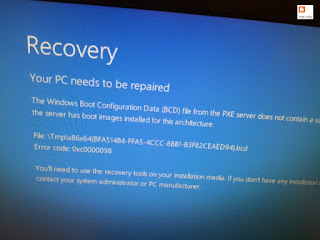Recently I did an upgrade of a ConfigMgr 2012 R2 SP1 environment to ConfigMgr Current Branch (1511). I did the following upgrades during the day (with some time and checks between them):
ConfigMgr server (1):
-Windows Server 2012 to Windows Server 2012 R2
SQL server (1):
-Windows Server 2012 to Windows Server 2012 R2
-SQL server 2008 R2 SP2 CU4 to SQL Server 2014 SP1
Site systems (3):
-Windows Server 2012 to Windows Server 2012 R2
ConfigMgr server (1):
ConfigMgr 2012 R2 SP1 to ConfigMgr Current Branch (1511)
This based on the following recommendations:
-ConfigMgr supports an in-place upgrade of the Operating System of the site server in the following situations: In-place upgrade from Windows Server 2012 to Windows Server 2012 R2
-When your version of ConfigMgr supports SQL Server 2014, ConfigMgr supports the in-place upgrade of SQL Server to SQL Server 2014 with the following limitations: Each ConfigMgr site must run a version of ConfigMgr that supports using SQL Server 2014 before you can upgrade to SQL Server 2014 at any site.
Source: Supported Upgrade Paths for Configuration Manager
After this upgrade(s), where everything did go fine, the default management wouldn't start anymore. This because of the error: HttpSendRequestSync failed for port 80 with status code 500 (mpcontrol.log).
Furthermore the Application Catalog didn't function also anymore. This because of the error: Component file list item in the install map for component SMS_DMAPPSVC_CONTROL_MANAGER does not contain srvboot.exe (sitecomp.log).
I did also get a error message during deployment: The Windows Boot configuration data file does not contain a valid OS Entry. Error code: 0xc0000098. Let's say: I wasn't amused here :-)
I did the following actions on the site system:
-Removed the management point and install it again
-Restarted MP component(s) in ConfigMgr Service Manager
-Restarted DP component(s) in ConfigMgr Service Manager
-Removed ASP.NET 4.5 (IIS) and install it again
-Checked if "Enable 32-Bit Applications" (IIS) was set to FALSE
-Removed both Application Catalog roles (still uninstalled)
-Checked if MP computer account is a member of MP Role (msdbrole_MP) in the SQL database.
-Restarted both ConfigMgr and SQL servers
But what I did, the error message came back everytime. In the end I removed the management point, and installed a new one on another server. This one was working immediately. Does anyone has a clue to resolve this at later time? Hope that the management point can be restored to the original location later!
This drives my crazy for multiple days now..
More websites about this topic:
The Windows Boot configuration data file does not contain a valid OS Entry
MP Control Manager detected management point is not responding to HTTP requests
SCCM MP Internal Server Error ISS Call to HttpSendRequestSync failed for port 80 with status code 500
Update 17-2: Thanks for comments already!
-The management point can be fixed when both MP and IIS role are removed. Reinstall them should be the solution. (to be continued)
-The application catalog can be fixed when copying the line "FILE <srvboot.exe><0><3667640>" and placed it into the SMS_DMAPPSVC_CONTROL_MANAGER component of install.map.
Update 2-3: After removing both roles (management point and application catalog) I removed IIS (and BITS) completely for the ConfigMgr server. After a required reboot I installed IIS (and BITS) again. After that both roles were installed successfully at first try. IIS re-install did it again :-)



Thanks for the post, stumbled across this after much google-fu and it resolved the issue for my single server SCCM deployment. Thanks!
ReplyDeleteThanks for sharing. Helped us after an update to version 1902 of the CB.
ReplyDeleteHello,
ReplyDeleteI applied the same steps mentioned in Update 2-3 and still receiving "MP Control Manager detected management point is not responding to HTTP requests. The HTTP status code and text is 500, Internal Server Error."